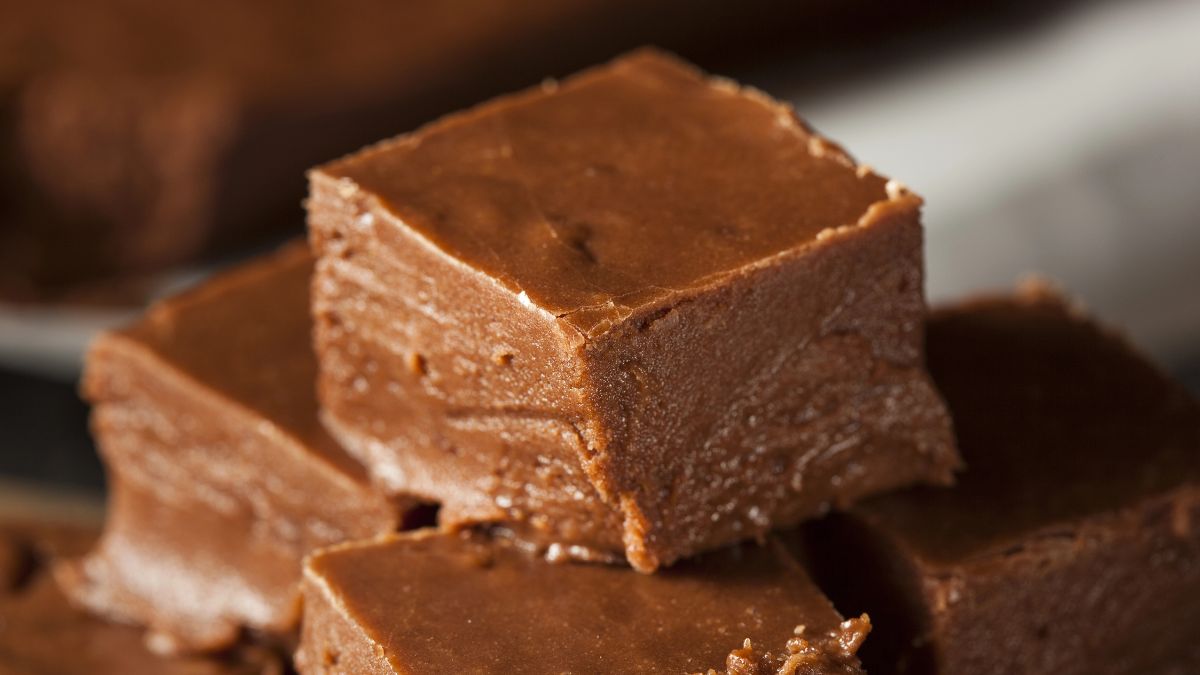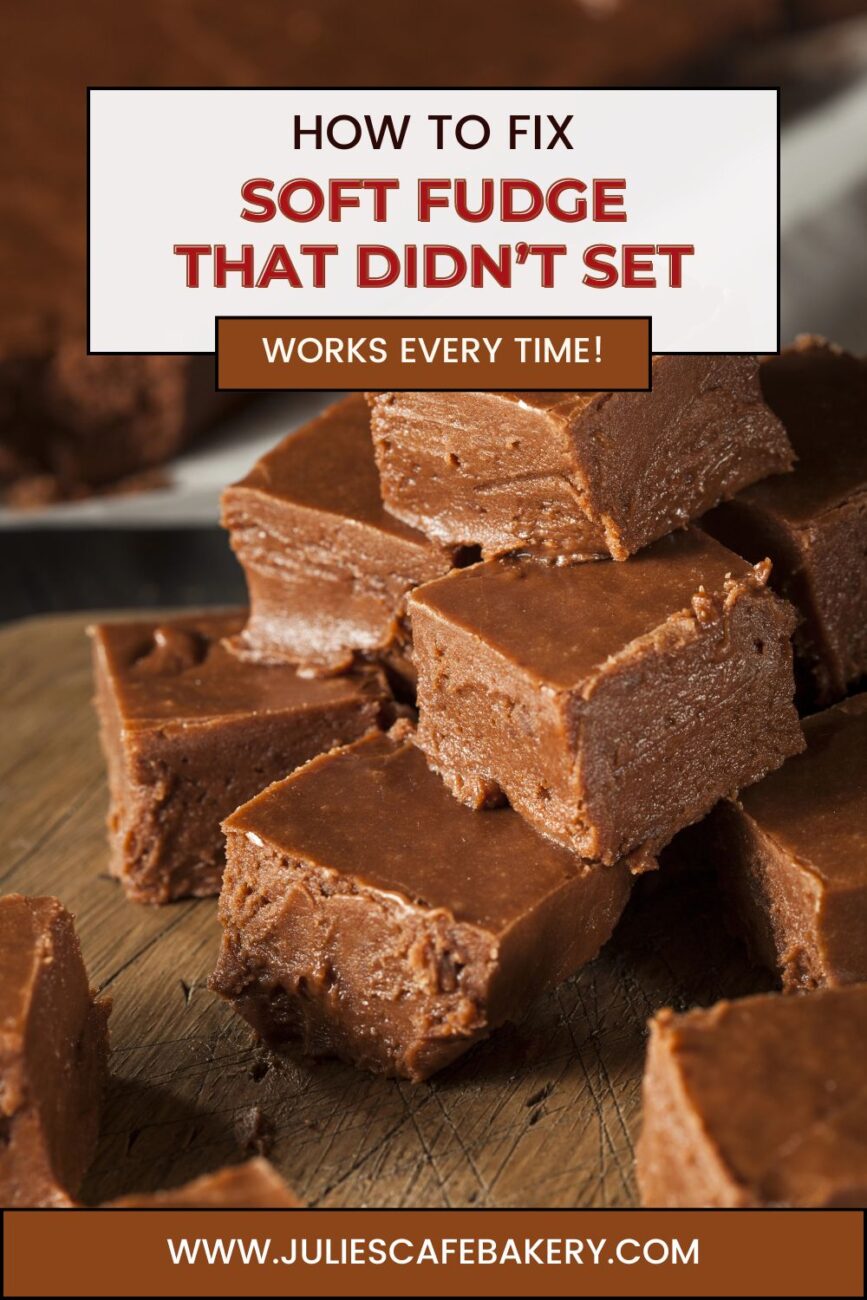Here’s How To Fix Fudge That Didn’t Set Properly

There is a certain consistency one expects from a good fudge. This consistency comes when the fudge is set properly. Otherwise, you will get a soft, gooey mixture that resembles an uncooked cake batter rather than a delicious piece of candy. So, how do you resolve this problem and fix the fudge that didn’t set?
You can fix the fudge that didn’t set by adding powdered sugar or a mixture of cornstarch and water. That will absorb excess moisture and make the fudge firm. You can also reheat the batter with a bit of water and get the temperatures as accurately as possible. Additionally, try to measure the wet ingredients precisely before adding them.
Your fudge might not set for several reasons, be it in the cooking process, not reaching the right temperature, or simply not using the right ingredients. So, in this article, I’ll go some of the common mishaps that lead to unset fudge and try to find a solution for each scenario. 🙂
Why doesn’t fudge set?
While fudge is not the most complicated confectionaries, you have to be mindful of some key areas when making it. If you get any of them wrong, the end product will leave you greatly underwhelmed.
Of course, there can be some exceptional situations that can account for fudge not setting properly. But here, we will discuss some of the common causes.

Not hitting the right temperature
Making fudge is similar to tempering chocolate in that you have to heat the mixture to a certain temperature before you let it cool down. For most fudge recipes, this ideal temperature ranges between 234 °F to 240 °F. And just like tempered chocolate, if the temperature is not right, the fudge will not set properly once cooled.
Not enough cooking time
Undercooked fudge is another common reason it will not set properly. When heating the fudge batter, you evaporate the water in it and let the sugar form crystals. The water ratio in the fudge will be a massive determining factor in how hard or soft your fudge is.
So, if you cook the fudge for too little time, not enough water will evaporate. This will lead to soggy, soft fudge that will not set. Conversely, the sugar will turn rock hard if you overcook or overheat the mixture.
Too much butter
Adding butter is a terrific way to make super moist and creamy fudge. But too much of it can do more harm than good. In this case, mixing too much butter in the fudge can make the batter runny. This will negatively affect how the fudge sets once you let it cool.
Too much milk/liquid
This is similar to putting in too much butter, only a lot more direct. Most recipes will call for the addition of milk (dairy or non-dairy) or simply water. But you have to add it in proper proportion. Otherwise, the whole mixture will have excess moisture that will ruin the consistency of the final product.
So, even when you cook the mixture for exactly the time specified in the recipe, you will still end up with unsettled fudge.
Beating the fudge without letting it cool first
Before you place the batch of fudge in a fridge to set, you need to beat it until it reaches a nice and smooth consistency. This is done right after you take the fudge off the heat. But you should allow the mixture to cool down to around 110 °F before you start beating it. Otherwise, you will end up with grainy, inconsistent fudge that will not harden correctly.
How to harden fudge?
A well-set fudge is firm enough to hold its shape on the outside. On the inside, it is soft yet chewy. To achieve this consistency in texture, you need to get some crucial steps correct. So, here are some tips on getting your fudge to harden properly:
Add powdered sugar
Sugar works by absorbing a lot of the water in the mixture, making the confectionary moist without making it too runny. So, if you are seeing that your fudge batter is too soft, try adding some powdered sugar to the mix and stir thoroughly to spread the sugar evenly. This will likely remove extra water to help with the hardening.
Put it in the freezer
If your fudge has failed to set and you are low on time to correct it, you can try a shortcut method with a freezer. Of course, this will not be a permanent solution as the fudge will become watery very soon after you thaw it. But it is a quick and easy solution to harden fudge that is too soft.
Additionally, storing fudge in a freezer can be a great way of preserving the baked good for months. So, place the fudge in a sealed container and leave it in the freezer until the time comes to eat them.
Reheat the fudge with evaporated milk
You can do this method to harden unset fudge only if it has not burned or overcooked. Add 1/8th of the amount of milk originally listed in your recipe and place the fudge over low heat. Slowly bring it to a boil and make sure you do not burn it. Remember to stir the milk continuously so that it spreads uniformly.
Water and cornstarch method
Cornstarch is an organic thickener and has a pretty neutral flavor. Meaning it will thicken up your fudge without tampering with the taste. Make a blend of water and cornstarch in a ratio of 1 to1. Now, carefully add just a small amount of it to your fudge at a time and stir vigorously. Adding too much may result in dry and hard fudge.
How far in advance can you make fudge?
Fudge can stay safe for consumption in a normal refrigerator for 2 to 3 weeks. This makes it an ideal treat to make in advance. You can extend its longevity further by storing it in a freezer, extending its freshness for 3-4 months. So, you can comfortably make fudge weeks before the upcoming holidays, saving you a lot of hassle.
In order to properly store fudge in a fridge, select it in an airtight container. Alternatively, you can wrap it in a plastic bag and squeeze all the air out of it. This will prevent the baked good from drawing unwanted moisture from the air, increasing its longevity. Then keep it in the fridge until the appropriate time.
Will fudge go bad in the fridge?
Fudge is not a highly perishable food. You can even leave it in the open for an extended period without it going bad. And it can easily last for several months in a freezer.
However, the quality and taste will decrease. The longer you wait, the more noticeable this drop-off will be. So, it is best to consume the fudge within a month of making it.
What happens if you put too much butter in fudge?
Butter is rich in fat, making any confection that much creamier and smoother. At the same time, however, the butter will also infuse plenty of moisture into the mixture.
So, adding too much of it to your fudge recipe can make the batter too watery. Then, when the cooling time comes, the fudge will not harden appropriately as there is too much moisture.
You can alleviate this issue by adding powder sugar or cornstarch to absorb the excess moisture. Both sugar and cornstarch work by retaining the water molecules and allowing the fudge to firm up. You can also add more flour to the fudge to gain the same effect.
How can you avoid fudge not setting?
When heating the fudge, make sure you get the right temperature and then let it cool down to the right temperature before you start beating it. Use the thermometer in both cases. Also, add the ingredients in proper proportions if you want your fudge to set properly.
Can you put fudge in the freezer to set?
You can put the fudge in a freezer to help it solidify faster. It can even temporarily firm up fudge that has not been set due to an error in cooking. But it will not be a permanent solution. Once you bring it out of the freezer and thaw it, the fudge will return to its soft and runny state.
Can you reboil fudge that didn’t set?
Yes, you can if the batter did not burn during the initial cook. You can reheat the fudge by adding extra liquid (milk or water). Make sure the temperature is precise and your dessert will likely harden properly. Always keep an eye on the thermometer, or you will risk burning the entire thing.
To conclude, making fudge is a balancing act where you need to get the temperature, portion of the ingredients, and timing right. But the decadent delight that awaits you at the end will make all of the efforts more than worth it.
